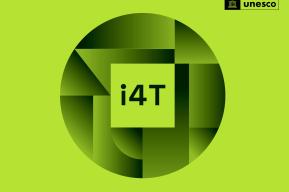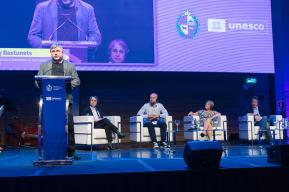Article
Coordinated action amplifies our impact on UN Plan on Safety of Journalists

Creating a safe environment for journalists cannot be accomplished by a single actor. To tackle the multifaceted challenges that guarantee both the independence of the media and the safety of journalists, the UN Plan of Action on the Safety of Journalists and the Issue of Impunity promoted a coalition-based approach, involving media, NGOs, academia and governments. Such approach implies the sharing of information but especially coordination to ensure complementarity among their actions.
From global to national level, the UN Plan of Action is implemented in collaboration with the UN Country Teams (UNCTs) and with the partnerships of relevant INGOs as well as representative of media outlets and journalists. In first decade of the implementation of the Plan, at global level, a group of more than 30 international non-profit organizations have created the “CSO Coalition on Safety of Journalists” to coordinate their work in an action-oriented manner.
It is a periodical and informal network, gathering the participation of press freedom monitoring and advocacy organizations; media development organizations, which manage long-term programmes to build local safety mechanisms, and organizations that are representative and/or membership-based from the journalism and media industry, which often undertake a mixture of monitoring, advocacy and safety activities.
UNESCO: Now we mark the 10th anniversary of the UN Plan of action, could you tell us more of what preceded its creation, especially in terms of the multistakeholder consultation process to arrive to such achievement?
Silvia Chocarro: It all started in 2010. I was working at UNESCO’s International Programme for the Development of Communication (IPDC). At the time, the UK Delegation to UNESCO proposed a text to be included into an IPDC’s Decision on the safety of journalists that requested “the Director-General of UNESCO to consult with Member States on the feasibility of convening an inter-agency meeting of all relevant UN agencies with a view to formulating a comprehensive, coherent and action-oriented approach to the safety of journalists and the issue of impunity”. A first UN-Inter-Agency Meeting on the safety of journalists took place and was attended by other UN bodies, States, civil society groups, professional associations, and media representatives. I remember it was the first time that the four Special Rapporteurs on freedom of expression from the UN and regional intergovernmental bodies met in person. It was quite a success! A final document was endorsed by the UN Chief Executive Board in April 2012. However, the critical part of the strategy was its implementation. Therefore, a second UN Inter-agency meeting that took place in Vienna in November 2012, in which representatives from fifteen UN bodies participated to ensure a coordinated engagement by UN agencies and bodies. Since then, there have been many consultations around the UN Plan implementation.
UNESCO: ARTICLE 19 is part of the International Civil Society Organization Safety of Journalists Coalition. In your view, how did the UN Plan of Action helped in establishing this coalition and to strengthen coordinated work?
S.C.: While coordination among civil society working on the safety of journalists always existed, I think that the process of the UN Plan brought us together towards its implementation and reinforced our coordination further. In fact, the creation of the International CSO SoJ Coalition took place just before the 5th anniversary of the UN Plan with our first action being to develop a set of recommendations to strengthen the UN Plan that were presented at the 5th anniversary conference of the UNPA that took place in Geneva in 2017. The Coalition has also come together to present a call for action on the 10th anniversary of the UN Plan.
UNESCO: What do you think have been the major achievements since its creation?
S.C.: To put the issue of the safety of journalists and the issue of impunity on the UN agenda -thirteen UN resolutions on the issue have been passed since then-, and on the agenda of the States. Also, it has been successful bringing the various actors together. Since 2012 there has been an increasing number of legislations, policies, different mechanisms and other initiatives at the international, regional and national level. Still, however, there is much more to do, as the challenges also grow. In terms of the ICSO SoJ Coalition, I think its main achievement has been to coordinate our voices in the international sphere to have greater impact, in particular at the UN.
UNESCO: Could you also illustrate one achievement you were directly involved with?
S.C.: ARTICLE 19 is the only organization that has been consistently working to push for more progressive language in all UN resolutions since the approval of the UN Plan, in particular at the Human Rights Council. Thanks to our efforts, there are very important commitments that have been made by States that civil society groups, media and journalists can use to put pressure on their States to improve the safety of journalists in their countries. When it comes to the ICSO SoJ Coalition, I am very proud of us having coordinated civil society inputs to some of the UN reports monitoring the implementation of UN resolutions. In 2013, for example, a few CSOs contributed to the first Human Rights Council report in response to a HRC resolution. In 2018, after the creation of the coalition, this number went up to 24. This is crucial, as these reports monitor the implementation of States commitment on the safety of journalists worldwide.
UNESCO: What have been the major difficulties that coalition-based actions have encountered to protect journalists? Have the results have been contrasted in different regions?
S.C.: I think we all agree that coordination is fundamental and that undoubtedly increase the impact of our work. However, implementing actions takes an incredible amount of time. I think donors who are funding this type of work need to take this into account. If we want to be more effective, we need to recognize the effort it takes to be effective in a coordinated manner. The same applies to the need of applying a gender-responsive approach to the work on the safety of journalists. If we do not want these issues to be just and add-on, it requires more time, and more resources. If can all recognize this, we will have a greater collective impact.
UNESCO: What aspects of coalition building can be improved 10 years from now to make them more effective?
S.C.: One of the areas where the coalition building around the UN Plan can be improved is coordination. There are more and more actors and initiatives around the world and we need to be able to be coordinated among all of us, learn from each other and build on each other’s work. I think we can start by creating a coordination advisory committee representing the various actors and initiatives.
Silvia Chocarro
Head of Protection of Journalists & Human Rights Defenders, ARTICLE 19
Silvia Chocarro has a career that spans over 20-years focusing on promoting the human right to freedom of expression and safety of journalists in particular. At the conception of the UN Plan of Action on the Safety of Journalists and the Issue of Impunity, she was working at the International Programme for the Development of Communication, (IPDC), under the leadership of its former Secretary Jayaweera Wijayananda; later, under Guy Berger. She has actively worked in the development of the Plan as she focused her PhD dissertation on the role of the UN in promoting the safety of journalists from 1945 to 2015. A summary can be accessed in the publication The Assault on Journalism Building Knowledge to Protect Freedom of Expression.
She is a former expert consultant on the Right to Freedom of Expression at IFEX. She implements and evaluates freedom of expression projects, in addition to designing advocacy and communication strategies. She has been a journalist in Mexico for different media outlets, such as Europa Press and the Spanish radio station Onda Cero. She has also worked for Radio France Internationale.








